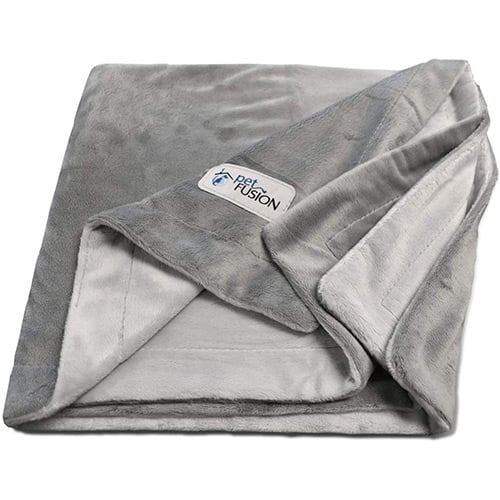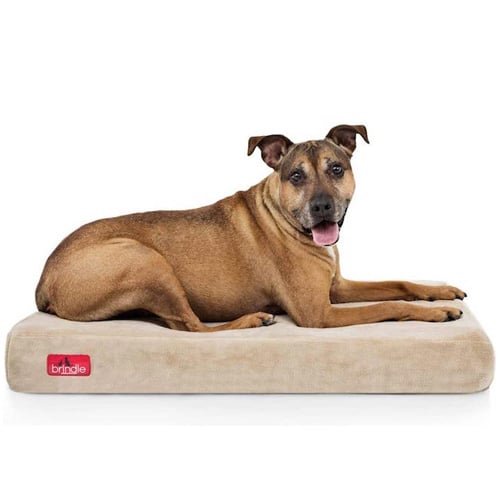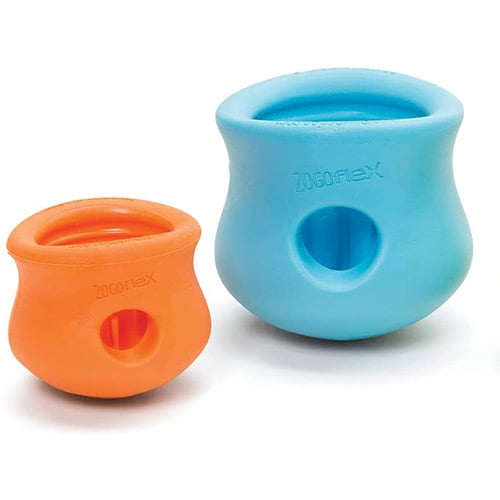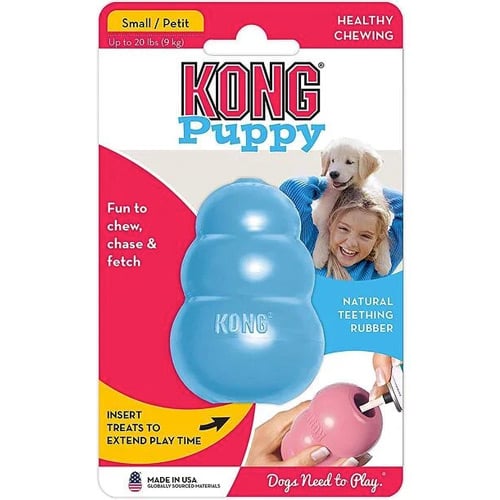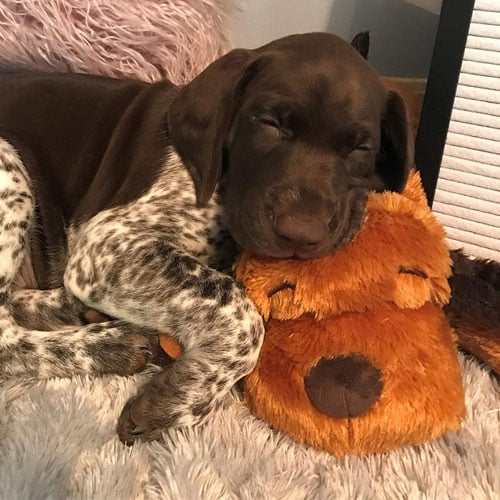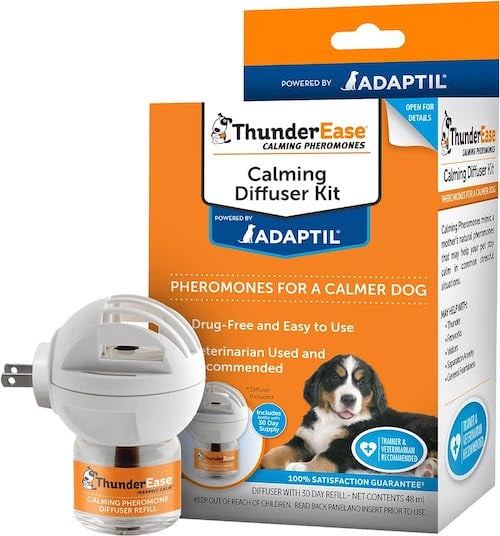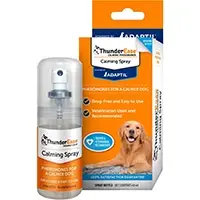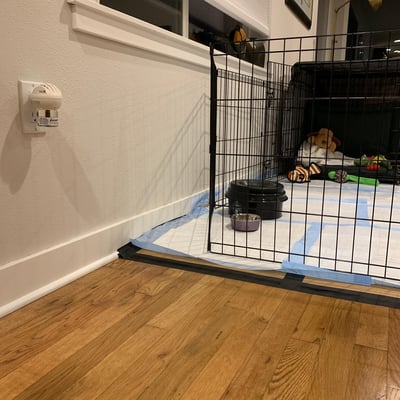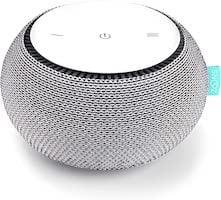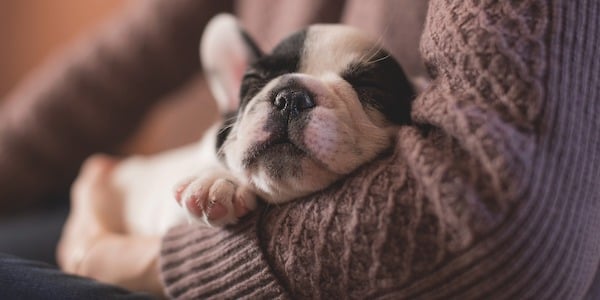 Are you finding it impossible to catch a good night's sleep ever since your adorable puppy came into your life? Wondering if you'll ever sleep again?
Are you finding it impossible to catch a good night's sleep ever since your adorable puppy came into your life? Wondering if you'll ever sleep again?
Don't worry, you're not alone! Most puppies struggle with sleeping through the night, especially when you first bring them home.
I'm going to share with you some tried and tested tricks and tips to help you and your puppy get as much sleep as possible.
Just like human babies, puppies require extra attention and management as they grow. Instead of diaper changes, your pup will need nighttime potty breaks until they are mature enough to hold it the whole night.
And even then, their morning might start a few hours before you prefer. While puppyhood doesn't last as long as "babyhood," it's important to understand that sleep training for a puppy takes time and patience.
I'll guide you through the process of establishing a sleep routine for your new puppy, with a focus on evening routines and nighttime potty breaks, with the goal of gradually extending their ability to sleep through the night.
Along the way, we will also address common concerns, such as why your puppy won't sleep and where they should sleep, so you both get good rest.
So, if you're tired of those sleepless nights and wondering if you'll ever sleep again, keep reading to discover practical solutions to help both you and your new furry family member get the rest you need.
Let's embark on this journey together and ensure a peaceful and restful sleep for everyone involved!
Why Isn't Your Puppy Sleeping Through the Night?
When Do Puppies Start Sleeping Through the Night?Where Should Your Puppy Sleep?
Creating a Comfortable Crate Space
Pre-Bedtime Exercise & Enrichment
Last-Chance Potty Break
Your Puppy's "Security Blanket"
Use Calming Dog Pheromones
Noise Techniques
Why Your Puppy Isn't Sleeping Through the Night
There are a few reasons why your puppy may not sleep peacefully through the night in the first few weeks after joining your family:
- They aren't used to sleeping without their littermates and mother. This can cause isolation distress.
- They can feel uncertain about their new surroundings. Everything smells and looks different, and they may hear sounds they've never heard before throughout the night.
This change may be exciting for them, making it hard to settle down and sleep, or it may be overwhelming and make them nervous. - Young puppies have small bladders. Most cannot hold it throughout an entire night, and many puppies instinctually don't want to soil where they sleep; they'll whine or cry in their crate if they feel the urge to go.
Essentially, it's about your puppy's adjustment period, their comfort levels, and their biology. Some puppies adjust to their new home quickly, while others can take a few weeks.
Make peace with the fact that you’re just not going to get a full night’s sleep for a few weeks. Oh, the joy of raising a puppy!But the time and dedication you put in now will help you reach that point sooner (before sleep deprivation makes you start speaking in tongues to shadow people).
When it comes to training your puppy to sleep through the night, crate training is incredibly useful and has many additional lifetime benefits beyond nighttime sleep.
You don't have to use a crate for your puppy's entire life, but when used correctly, their crate becomes their safe place, and many dogs prefer it. Plus, it's an important management tool when potty training a puppy.
Check out my behavior and training tips in "Crate Training Your Puppy at Night" to get the most out of a nighttime crate setup.
Below are some of my favorite techniques for helping your puppy settle and "must-haves" for setting up a peaceful sleeping area, and help soothe them into a blissful sleep.
When Do Puppies Start Sleeping Through the Night?
 Most puppies will sleep through the night by the time they’re about 4 months (16 weeks) old.
Most puppies will sleep through the night by the time they’re about 4 months (16 weeks) old.
But with some help, diligence, and proactive training, you may be able to get your puppy there even earlier!
When I brought Fozzie Bear home, he slept more peacefully during the night by 10 weeks old, but I still needed to take him out for nighttime potty breaks until he was 15 weeks old.
As you can see in the inset photo, we had some tough nights ourselves!
Every puppy is different, and yours may need more or less time to acclimate and settle at night.
Just remember, your patience, compassion, and consistency will be worth it in the end — for both of you.
Where Should Your Puppy Sleep?
While you may eventually want to let your dog sleep in bed with you (or your kids), it really is best if your pup starts out sleeping in a crate — you can always let them in the bed later, once they’re fully potty-trained, sleeping soundly, and happily acclimated to their crate.
Crate training is always easier when started young, rather than trying to get them comfortable sleeping in a crate later in life.
With that said, it's okay if you decide crate training isn't for you and your puppy. Just know that they may experience stress later on in life if at the vet or groomer and need to be confined in a crate or kennel space.
There are ways to help them sleep through the night without using a crate, which I'll explain further below.
Whether you put their crate in your bedroom or in a separate room, that’s a different topic altogether. Check out this article to learn more about crate setup for your puppy's comfort and safety.
Creating a Comforting Sleeping Space for Your Puppy
The type of crate you choose can help or hinder your puppy's ability to fall and stay asleep. Some puppies do better with a full view of their surroundings, but I've found most prefer a more "den-like" crate.
If you're debating what type of crate to purchase or how to measure a dog crate (especially to fit your puppy as they grow), learn more in "Choosing the Best Dog Crate for Your Dog and Your Life."
In that article, you'll see what I personally use and tricks for making a crate "grow" with your puppy.
Use a Crate Cover to Help Your Puppy Sleep
Just like you, your pup’s sleep-wake cycles are influenced by melatonin, a hormone that is affected by the amount and duration of light in the environment. Melatonin is a sleep-inducing hormone, and its production goes up when the lights go down.
So, a crate cover can really help with long days when the sun rises early and sets late. Be sure to also turn off the lights in the room where your pup is sleeping. This means turning off the phone, tablet, and TV screens, too.
If you choose to use a wire crate, you may want to consider adding a crate cover like this one (make sure to choose the size that fits the crate you have). It's not necessary, but it could possibly help block out excess light and noise.
If your puppy is helped by having their crate covered, this is likely a better option than towels, sheets, or blankets, as this fits more snuggly, possibly allows better airflow, and looks nicer.
Most importantly, properly fitted crate covers are less likely to get pulled through and eaten.
However, if your dog does have a habit of pulling their crate covering through the sides of the crate and eating them, I recommend against covering their crate at all.
Use the Co-Sleeper Hack
This training hack, created by Kim Brophey, is a wonderful option for puppies who are struggling in the crate at night or for those who aren't crate training their puppy. It provides a safe place for your puppy to stay while you sleep and keeps them close to you.
Dogs want to sleep close to their family, and this setup allows you to provide comfort when they need it.
Set up a dog bed right next to your bed and tether your puppy to the top leg of the bed on your side with a leash attached to their collar or harness. The leash should only be long enough for your puppy to spread out on their bed.
Make sure there is a bowl of fresh, clean water within your puppy's reach, and stock their area with safe chew toys. This way they have something appropriate to do if they get bored or need to self-soothe.
If your puppy starts whining or can't settle down, provide them some reassurance by touching them with your hand and calmly telling them they are doing okay. If they don't settle within a minute or two, then take them out for a potty break before returning to bed.
Download this Co-Sleeper Hack handout for instructions and tips.
Make Sure Your Puppy's Bedding is Comfortable
Dogs can be pretty resilient when it comes to finding a space to sleep, but that doesn’t mean they don’t like to be comfy, too. But comfort is in the eye of the beholder! Some puppies prefer lots of fluffy towels or blankets to nestle in, while others seem to prefer cold, hard floors.
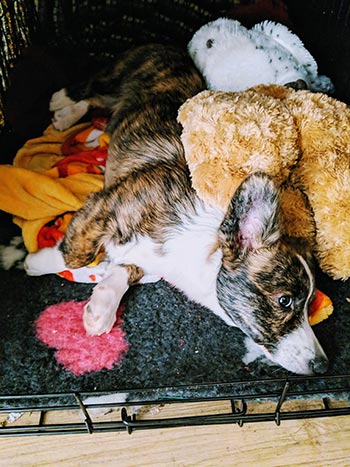
If your puppy is too warm or too cold, they may wake up and start whining, so pay attention to their preferences and adjust their bedding as needed to help them sleep longer.
You might need to experiment with what bedding you put in your puppy's crate at night to see what they are most comfortable with, whether it's super soft and warm or just a crate pad and blanket.
If your puppy is prone to shredding or eating blankets or towels, you will want to choose chew-proof bedding to make sure they stay safe.
Pro Tip: For young puppies, look for a bed or mat that’s waterproof, or at least easily washable, and also chew-proof!
The bedding options I recommend below are durable, comfortable, washable, or waterproof, making them a good fit to cozy up the bottom of your puppy's crate.
(I even use the PetFusion blanket for myself sometimes when my pups feel like sharing it with me — it's that cozy!)
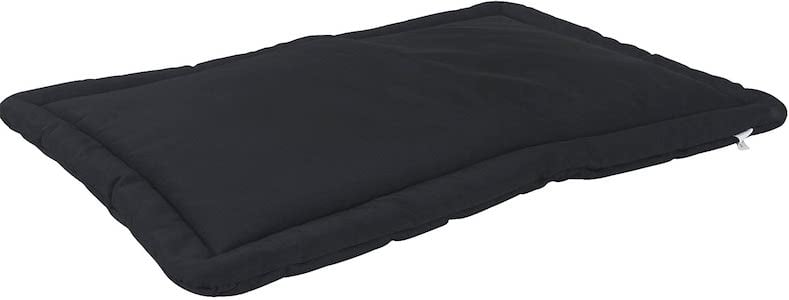
Burn Some Puppy Energy Before Bedtime
Make sure to give your pup plenty of mental enrichment and exercise throughout the evening and before bedtime. If they’re just lounging around at night while you’re watching TV, they’re likely to get their ZZZs in early so they’ll be wide awake when you’re ready for bed.
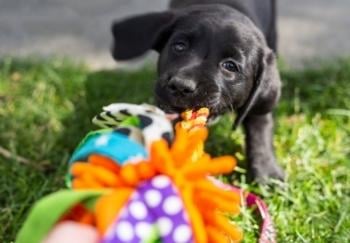 Evening Puppy Exercise
Evening Puppy Exercise
Spend a good 10–20 minutes playing with your pup (outside or inside) a couple of times during the evening. Play a game of tug or get them interested in chasing a flirt pole.
Not only will this tire them out, but it will also give them some important physical exercise. It’ll also help get things moving to help them “clear the pipes” before bedtime.
Evening Brain Games and Training
Use the commercials during your evening television shows to practice some basic training cues with your puppy. Not only does this work their brains and take the edge off, but it also builds your relationship with your puppy and promotes a solid training foundation.
A puppy's attention span is pretty short, so keep training sessions short and sweet and spread them out throughout the day.
Ditch the regular food bowl and use a puzzle feeder for your puppy's evening meal. Below are some of my favorite food puzzles and interactive feeders. They're fun for dogs and tricky enough to engage their brains, yet not so difficult that a dog will become frustrated and give up.
I recommend starting with the West Paw Toppl (featured below) for your puppy's first interactive feeder, as the opening is wider than a Kong toy — making it easier to de-stuff (and for you to stuff and then clean afterward!).
As your puppy is successful with easier stuffed toys, they can move up to more difficult puzzles!
You can see my puppy Fozzie Bear going to town on his Toppl toy during crate acclimation in this video:
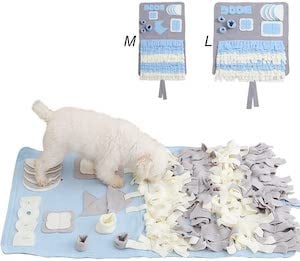
Calming Pre-Bedtime Puppy Activities
Licking, chewing, and sniffing are part of what I call the "Calming Trifecta." You can use these things to help a puppy settle and get more relaxed prior to bedtime. The repetitive nature of these things is self-soothing to your puppy (much how activities like knitting are for us).
The snuffle mat I recommended above is a great way to work their nose indoors, or you can scatter their food in the grass of your yard for them to sniff out. Freeze your puppy's meal in their Toppl to make it last longer, or use a licking mat smeared with a tiny bit of peanut butter or wet food for a good lick session.
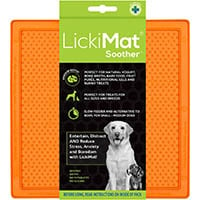
Find more ideas for calm puppy bedtime activities in my article "3 Ways to Calm Down a Hyper or Anxious Dog."
Last-Chance Potty Break!
Take your puppy out for a bathroom break as late as possible — ideally, the last person to bed should also take your pup to their potty spot. This helps empty them out, decreasing the chance of them needing to go in the middle of the night.
Keep this last potty break calm and boring. You don't want your sleepy puppy finding their second wind!
On this note, consider your puppy's evening mealtime. You don't want to feed your puppy too late in the evening that they need to go #2 in the middle of the night. However, if you feed them too early, they may be hungry at bedtime, and that can make them restless.
One way to prevent late-night hunger is to use food puzzles with small "snack-sized" portions of food as their pre-bedtime enrichment.
When it comes to leaving water in your puppy's crate, I always recommend free access to water at all times. Water is a "primary resource" — meaning your puppy needs it to survive. And there are some medical conditions that require access to drinking water at all times.
But, if your puppy is waking up continually during the night because they need to urinate, speak with your veterinarian to first rule out medical reasons (such as a urinary tract infection) and then discuss with them whether restricting access to water before and during the night is a good choice for your puppy.
Keeping a puppy potty log can really help you determine your puppy's natural potty schedule, which can help you adjust feeding times to increase longer sleep time at night. Download our free potty log template.
PRO TIP: It can be helpful to set an alarm for yourself during the night to wake up and take your puppy for a quick potty break. It's all about being proactive — with an alarm, your puppy won't wake up feeling like they're ready to burst and start whining or crying in their crate.
As they mature, your alarm can be set later and later as they can physically hold it longer. For more tips on potty training, check out "How to Potty Train a Puppy."
Give Your Puppy a "Security Blanket"
The Snuggle Puppy is cute enough to warm your heart, but more importantly, it'll give your pup some much-needed comfort as they get settled into their new home. The transition from sleeping in close proximity (skin-to-skin ... or fur-to-fur perhaps) with their littermates to suddenly sleeping alone can be distressing for many puppies.
This cuddle buddy, with its “real-feel” heartbeat (which dogs can both hear and feel) and its gentle warmth heat source, is a "super stuffy” that really can help ease this transition.
The reviews and photos people have submitted for this product are absolutely heartwarming, you really should check them out.
When I picked up my puppy Fozzie Bear from his breeder, I brought a Snuggle Puppy along and made sure his mom's and littermates' scents were on it before heading back home.
I like to believe that he found having a familiar scent paired with the heartbeat sound and heat pack very comforting as he learned to sleep in his crate.
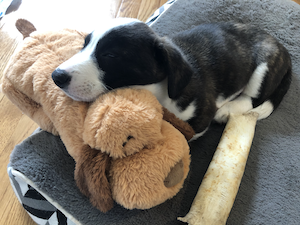
He certainly loved to cuddle with it, and even after he transitioned to sleeping outside of the crate once he was old enough, he still carried the Snuggle Puppy around to use as a pillow, as you can see in the inset photo.
The Snuggle Puppy can last for years. Even when your dog doesn't need it at night, just take out the batteries and heating pack, and your dog will still carry it around!
Another important feature of the Snuggle Puppy is that it's washable (just don't forget to remove the batteries first!*).
Another Preventive Vet staff review: "Mary Berry was having a difficult time sleeping alone in her crate — our guess was that she was missing her mom and littermates. The first night we put the Snuggle Puppy inside Mary Berry’s crate, she slept soundly, only waking up to be let out for a bathroom break.
She slept so soundly with the Snuggle Puppy; we would bring it with us when visiting friends so she had a comfortable piece of home to rest with. I highly recommend the Snuggle Puppy to help your new puppy sleep through the night!"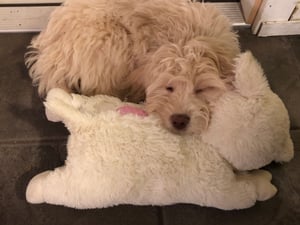
*Safety Tip: Speaking of batteries, be sure to keep a close eye on your dog when they're first interacting and snuggling with their Snuggle Puppy!
If your dog's idea of "snuggling" this toy involves mouthing, chewing, or disemboweling, be sure to take the toy away from them. Batteries are very dangerous for dogs if they are swallowed.
Soothing Scents for Your Puppy
Using dog-appeasing pheromones (also called DAP) can help your puppy feel secure and calm, as these mimic the pheromones their mother emits during nursing. Pheromones work for many puppies, but not all.
But there's no downside to trying it out with your pup, so it's something I regularly recommend.
The ThunderEase pheromone diffuser covers a large space and lasts for 30 days before needing a refill. You might even try a spritz from a ThunderEase spray on bedding shortly before placing your puppy in their crate. (Just one or two spritzes are all you need!)
If you use the diffuser plug-in, make sure it's outside of your puppy's area so they don't decide to make it a chew toy. Here's a photo showing the ThunderEase diffuser plugged in outside of Preventive Vet pup Finnegan's playpen:
Play Calming Sounds
Turning on mellow music can help lull your puppy to sleep, as well as do double duty of masking other sounds that might wake them up. A common go-to for calming music for dogs is classical, but if that's not your puppy's jam, try out some soft rock or reggae. You can learn more here about what types of music help calm dogs.
If music is too distracting for you or your puppy, turn on a fan for white noise or use a sound machine. I personally use the SNOOZ white noise machine listed below. I love the convenience of setting a timer with an app and being able to change the pitch as needed to block out city noise outside.
You can also check out YouTube for long playlists of calming music for dogs or find them on Spotify to play on your smart speaker.
Or consider setting up a dog-specific speaker, like this one, which comes preloaded with over three hours of Through a Dog's Ear music on an SD card (also available through YouTube), specifically created to help calm anxious or fearful dogs.
What's worked best for you in helping your puppy sleep? Let us know in the comments!





